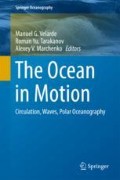Abstract
Modern numerical models of the Arctic Ocean (AO) exhibit the great progress partly thanks to the fine horizontal resolution, which helps to resolve many of the relevant processes explicitly. Nevertheless, some of the AO features are still modeled poorly by the models with a resolution of 5–10 km. It is anticipated, that the further increase in the horizontal resolution up to 100–1000 m will demand the understanding of the role of the AO specific processes. This paper is a brief review of some of such processes like mesoscale and submesoscale eddies and internal waves, and of the problems of their parameterization, caused by the closeness of their spatial scales. The internal waves and the internal wave-induced mixing are assumed to be the key processes to be taken into account to describe the AO cold halocline mixing properly.
Access this chapter
Tax calculation will be finalised at checkout
Purchases are for personal use only
References
Aksenov, Y., Karcher, M., Proshutinsky, A., Gerdes, R., de Cuevas, B., Golubeva, E., et al. (2016) Arctic pathways of Pacific Water: Arctic Ocean model intercomparison experiments. Journal of Geophysical Research Oceans, 121, 27–59.
Fer, I. (2014). Near-inertial mixing in the central Arctic Ocean. Journal of Physical Oceanography, 44, 2031–2049. https://doi.org/10.1175/JPO-D-13-0133.1.
Fox-Kemper, B., Ferrari, R., & Hallberg, R. (2008). Parameterization of mixed layer eddies. Part I: Theory and diagnosis. Journal of Physical Oceanography, 38, 1145–1165.
Gent, P. R., & McWilliams, J. C. (1990). Isopycnal mixing in ocean circulation models. Journal of Physical Oceanography, 20(1), 150–155.
Hines, C. O. (1997). Doppler spread parameterization of gravity wave momentum deposition in the middle atmosphere. Part 2. Broad and quasimonochromatic spectra, and implementation. Journal of Atmospheric and Solar-Terrestrial Physics, 59, 387–400.
Iakovlev, N. G. (2012). On the simulation of temperature and salinity fields in the Arctic Ocean. Izvestiya Atmospheric and Oceanic Physics, 48(1), 86–101. https://doi.org/10.1134/S0001433812010136.
Iakovlev, N. G., Volodin, E. M., & Gritsun, A. S. (2016). Simulation of the spatiotemporal variability of the World Ocean sea surface height by the INM climate models. Izvestiya Atmospheric and Oceanic Physics, 52(4), 376–385. https://doi.org/10.1134/S0001433816040125.
Large, W. G., McWilliams, J. C., & Doney, S. C. (1994). Oceanic vertical mixing: a review and a model with a nonlocal boundary layer parameterization. Reviews of Geophysics, 32, 363–403.
LeBlond, P. H., & Mysak, L. A. (1978). Waves in the ocean (p. 602). Amsterdam: Elsevier Oceanographic Series, Elsevier Scientific Publishing Company.
Marshall, J., Hill, C., Perelman, L., Adcroft, A. Hydrostatic, quasi-hydrostatic, and nonhydrostatic ocean modeling. Journal of Geophysical Research, 102(C3), 5733–5752.
McPhee, M. G., & Kantha, L. H. (1989). Generation of internal waves by sea ice. Journal Geophysical Research, 94(C3), 3287–3302.
McWilliams, J. C. (2016). Submesoscale currents in the ocean. Proceedings of the Royal Society of London A, 472, 20160117. https://doi.org/10.1098/rspa.2016.0117.
Morozov, E. G., & Pisarev, S. V. (2002). Internal tides at the Arctic latitudes (numerical experiments). Oceanology, 42(2), 153–161.
Morozov, E. G., & Paka, V. T. (2010). Internal waves in a high-latitude region. Oceanology, 50(5), 668–674. https://doi.org/10.1134/S0001437010050048.
Morozov, E. G. (1995). Semidiurnal internal wave global field. Deep-Sea Research, 42(1), 135–148. https://doi.org/10.1016/0967-0637(95)92886-C.
Morozov, E. G., Paka, V. T., Bakhanov, V. V. (2008) Strong internal tides in the Kara Gates Strait. Geophysical Research Letters 35(16). https://doi.org/10.1029/2008gl033804.
Morozov, E. G., & Marchenko, A. V. (2012). Short-period internal waves in an arctic Fjord (Spitsbergen). Izvestiya Atmospheric Oceanic Physics, 48(4), 401–408. https://doi.org/10.1134/S0001433812040123.
Morozov, E. G., Kozlov, I. E., Shchuka, S. A., & Frey, D. I. (2017). Internal tide in the Kara Gates Strait. Oceanology, 57(1), 8–18. https://doi.org/10.1134/S0001437017010106.
Morozov, E. G., Pisarev, S. V., Neiman, V. G., & Erofeeva, S. Y. (2003). Internal tidal waves in the Barents Sea. Doklady Earth Sciences, 393(8), 1124–1126.
Morozov, E. G., & Pisarev, S. V. (2003). Internal waves and polynya formation in the Laptev Sea. Doklady Earth Sciences, 398(7), 983–986.
Nurser, A. J. G., & Bacon, S. (2014). The Rossby radius in the Arctic Ocean. Ocean Science, 10, 967–975.
Palmer, T. N., Shutts, G. J., & Swinbank, R. (1986). Alleviation of a systematic westerly bias in general circulation and numerical weather prediction models through an orographic gravity drag parameterization. Quarterly Journal of the Royal Meteorological Society, 112, 1001–1031.
Proshutinsky, A., Steele, M., & Timmermans, M.-L. (2016). Forum for Arctic modeling and observational synthesis (FAMOS): past, current, and future activities. Journal of Geophysical Research Oceans, 121, 3803–3819. https://doi.org/10.1002/2016JC011898.
Rudels, B., Jones, E. P., Anderson, L. G., Kattner, G. (1994) On the intermediate depth waters of the Arctic Ocean. In O. M. Johannessen, R. D. Muench, J. E. Overland (Eds.), The Polar Oceans and their role in shaping the global environment. Geophysical monograph. 85: 33–46.
Serreze, M. C., & Barry, R. G. (2011). Processes and impacts of Arctic amplification: a research synthesis. Global and Planetary Change, 77, 85–96.
Timmermans, M.-L., Toole, J., Proshutinsky, A., Krishfield, R., & Plueddemann, A. (2008). Eddies in the Canada Basin, Arctic Ocean, observed from ice-tethered profilers. Journal of Physical Oceanography, 38, 133–145.
Visbeck, M., Marshall, J., Haine, T., & Spall, M. (1997). Specification of eddy transfer coefficients in coarse resolution ocean circulation models. Journal of Physical Oceanography, 27, 381–402.
Voltzinger, N. E., & Androsov, A. A. (2016). Nonhydrostatic dynamics of straits of the World Ocean. Fundamentalnaya i prikladnaya gidrofizika, 9(1), 26–40. (in Russian).
Acknowledgements
The study was performed at the Institute of Numerical Mathematics, Russian Academy of Sciences and supported by the Russian Science Foundation, grant 14-27-00126.
Author information
Authors and Affiliations
Corresponding author
Editor information
Editors and Affiliations
Rights and permissions
Copyright information
© 2018 Springer International Publishing AG, part of Springer Nature
About this chapter
Cite this chapter
Iakovlev, N.G. (2018). Arctic Ocean Modeling: The Consistent Physics on the Path to the High Spatial Resolution. In: Velarde, M., Tarakanov, R., Marchenko, A. (eds) The Ocean in Motion. Springer Oceanography. Springer, Cham. https://doi.org/10.1007/978-3-319-71934-4_35
Download citation
DOI: https://doi.org/10.1007/978-3-319-71934-4_35
Published:
Publisher Name: Springer, Cham
Print ISBN: 978-3-319-71933-7
Online ISBN: 978-3-319-71934-4
eBook Packages: Earth and Environmental ScienceEarth and Environmental Science (R0)

